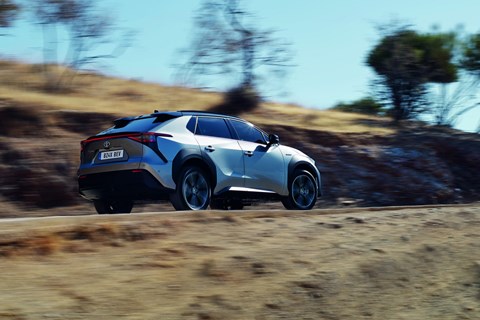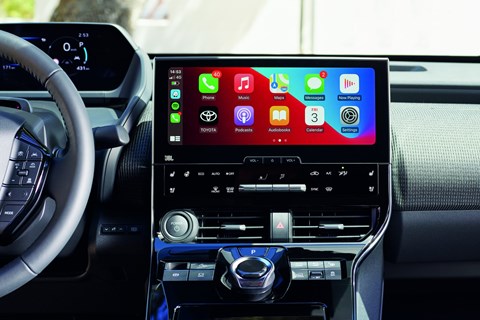► Toyota's first purpose-built BEV
► Order books opening on 15 December
► bZ stands for 'Beyond Zero' emissions
The new Toyota bZ4X has been revealed, with the company's first purpose-designed electric car set to be launched in Europe in December ahead of the first customer deliveries in 2022.
The bZ4X uses the e-TNGA platform that the Japanese firm has co-developed with Subaru, which plans to launch the electric Solterra SUV next year. As a similar size to the RAV4, it'll compete with the likes of the VW ID.4, Mazda MX-30, Volvo XC40 Recharge, Ford Mustang Mach-E and the forthcoming Nissan Ariya.
The badge stands for 'Beyond Zero', as Toyota begins a new chapter of zero-emissions electric vehicles that will be sold alongside its petrol, hybrid and hydrogen powertrains. The bZ4X is the first of 15 all-electric Toyotas planned for 2025.
Toyota bZ4X performance figures
Toyota says that the bZ4X will be offered with a choice of front- or all-wheel drive: the former uses a single motor that generates 201bhp and 195lb ft of torque, resulting in 0-62mph in 8.4sec and a top speed of 8.4sec.
Meanwhile the AWD alternative features a motor on each axle for a total output of 216bhp and torque of 248lb ft, shaving seven-tenths of a second off the 0-62mph sprint. It's also equipped with a single-pedal driving mode and settings for tackling snow, mud and other forms of tricky terrain which amounts to 'class-leading off-road handling' according to Toyota.

A 71.4kWh battery gives a range (provisional for now) of around 280 miles, with charging of up to 150kW allowing an 80% top-up in half an hour. From launch the bZ4X comes equipped with a 6.6kW on-board charger, but there's an upgraded 11kW unit in the pipeline already for the fourth quarter of 2022.
In a first for Toyota the battery is water-cooled, and the manufacturer claims that clever management of the cells' temperature means they will retain 90% of their performance after 10 years or 150,000 miles of use.
Toyota is also among the first manufacturers to incorporate solar technology into an electric car, with panels in the roof of the bZ4X helping to replenish the battery while on the go or when parked.
The car is based on the group's latest e-TNGA platform, a scalable platform that will underpin several new models in the future. Working in tandem with Subaru has allowed Toyota to maximise the car's potential off-road, while introducing a cultural shift that involved more collaboration with a variety of partners. The belief is that pooling knowledge and spreading costs will aid the development of the firm's new electric vehicles over the next few years.
Toyota bZ4X tech and interior
Inside the bZ4X is there's a reassuring mix of switches and screens, with three seats in the back, conventional door mirrors rather than a camera-based system, and twin sunroofs. The floor is flat for rear passengers (owing to the location of the battery in the floor) and Toyota claims the legroom is Camry-spec spacious.

Even the steering system has been adapted in the name of improving passenger space, with a steering-by-wire setup in place of a conventional system. Removing the mechanical linkage results in more legroom, and with no physical connection between the front wheels and the driver's hands, the electronics can dampen out any disruption from rough road surfaces while still offering the driver precise control.
Chief engineer Koji Toyoshima says the aim is a calm, connected cabin that's a good environment for quality family time: 'Our target customer is someone who places importance on time spent together with family and friends. When they want to enjoy such times, Toyota bZ4X Concept can serve as a hub for them.'

Note also how the newly compact steering arrangement frees up space for a more compact instrument pack, just like in Peugeot's i-Cockpit raised dials. A seven-inch display sits behind the wheel, with a large infotainment screen placed at the top of the centre console.
Boot space amounts to 452 litres with the rear seats in place, and Toyota promises the latest driver assistance tech through its third-generation Safety Sense system. Further upgrades will arrive in the future via over-the-air updates.
Where's the exterior design come from?
The production version of the bZ4X has stayed faithful to the concept that preceded it, with the design clearly related to the angular RAV4, the striking C-HR and 2021's Aygo X Prologue Concept, which makes similar use of contrasting black paint on the roof and underside.
There's no conventional grille – instead a 'hammerhead' look, with squinty LED eyes – although there is a slim, lower grille that uses a shutter to channel cooling air to the battery when required.

Riding on 20-inch wheels this is a highly conventional car, clearly intended for mass sales and, Toyota says, designed to make the transition from petrol to electric easy for drivers and their families.
It's the result of a five-year project, with input from Toyota designers around the world.
A slew of electric Toyotas coming soon
Unlike the electric UX 300e from upmarket sub-brand Lexus, the first mainstream production EV to wear a Toyota badge will use a bespoke platform, rather than one adapted from a combustion-engined model. Called e-TNGA, the platform has been designed to use batteries and e-motors rather than fuel tanks and engines, with the result that a car can be roomier inside.
The plan is that by 2025, Toyota’s global line-up will include 70 electrified vehicles – including ‘self-charging’ hybrids, plug-in hybrids, hydrogen fuel-cell vehicles and full electrics. There will be 15 battery electric cars by 2025, seven of them in the new bZ family (the others mostly being electric versions of existing models).
Why bZ? It stands for ‘beyond zero’, signalling Toyota’s intention to not just become carbon-neutral in every aspect of car creation and use, but to actively make the world a better place.
Chief engineer Toyoshima says: ‘This is not just about contributing to the environment by being a zero-emission vehicle but giving value beyond zero emissions by making driving easier and more fun.’
The Toyota Beyond Zero programme is designed to drive down the emissions of its vehicles and their manufacturing footprint. It is targeting an aggressive electrification programme that in Europe will mean:
- 70% of its vehicles will be hybrid by 2025
- More than 10% will be plug-in hybrids (PHEVs)
- More than 10% will be zero-emissions (battery electric or hydrogen fuel-cell)
The company that pioneered the hybrid vehicle powertrain has already trimmed a claimed 22% from its vehicle emissions from 2010-2019; the next chapter of its Beyond Zero project will drive that down further.
Carlucci explained that different markets were ready to go full-electric at different times. 'We are global manufacturers, probably the most global of any. We recognise the different speeds of going electified. We want to offer the right product at the right moment. There’s a lot of regulation and a lot of speculation about the end of ICE. We will continue to provide a wide range.
'Electric is a portion of the market, but we have to look globally at what we want to offer. And when we talk about carbon neutrality, we have to look at the entire cycle – what it means to produce electricity. Is it completely green today in Europe? No. Does it make sense to have very heavy batteries which cost more in terms of recycling? We don’t have all the answers. But for sure we ask these questions. We don’t have just one solution to going to carbon neutrality by 2050.'
Further reading
The best electric cars on sale today
The best electric SUVs
How much does it cost to charge an electric car?